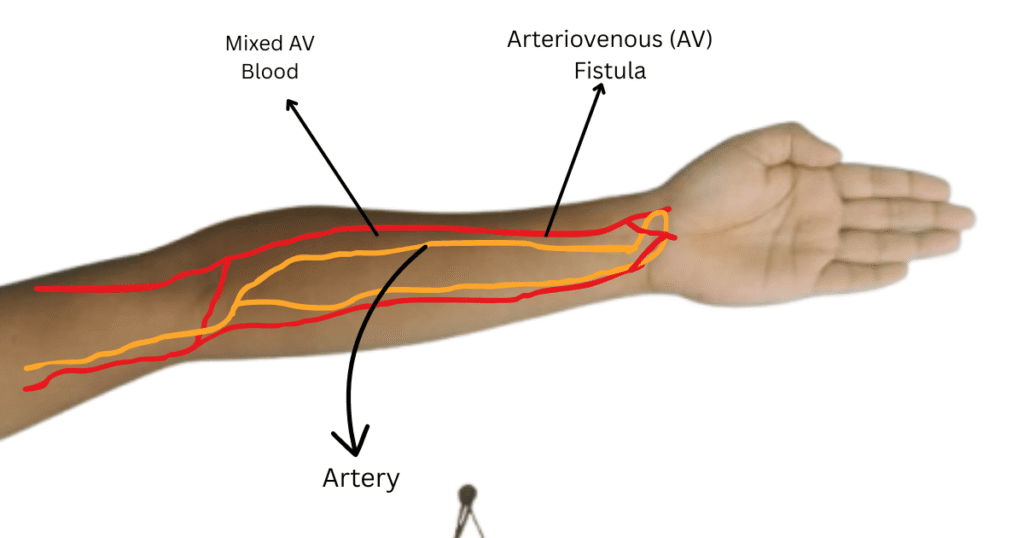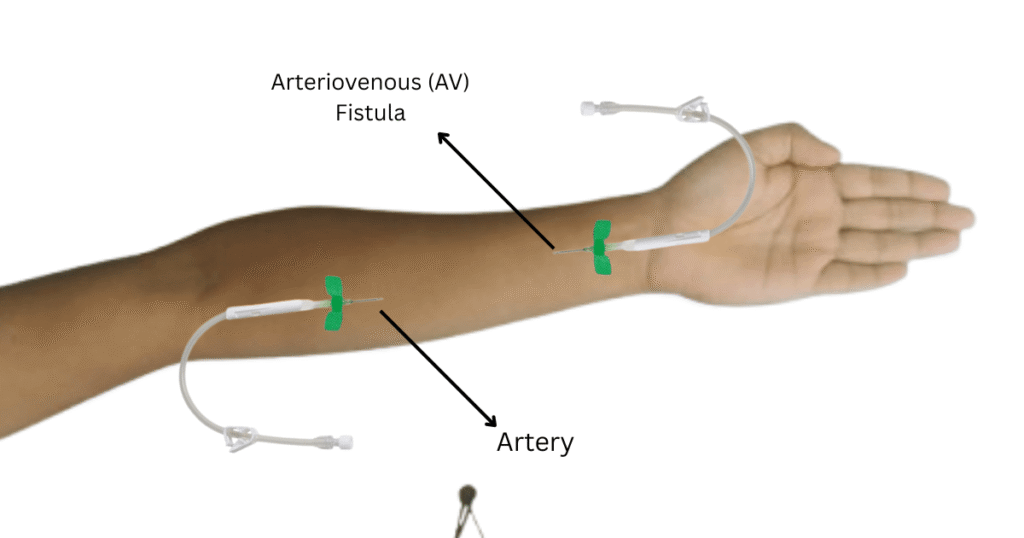An arm healthy fistula is an artificial blood vessel created for dialysis patients. It is made at the junction of a vein and an artery. The AV fistula basically works for blood circulation, which is very important for dialysis. Along with controlling blood flow, the fistula works by creating long-term, safe and fewer complications for dialysis patients. It is created through surgery, and the patient has to follow some rules to recover properly. We will know about all the functions and benefits, disadvantages, and regulations of fistula in this article.
Table of Contents
What is arm healthy fistula?
Healthy awareness is very important in our daily life. For this, we need some daily exercise, food, and enriching our capacity with wholesome nutrition. The important part of our body is the arm healthy fistula. The use of the arm is essential in the field of applying our strength. In addition, taking the advice of a doctor is also necessary. A fistula is a narrowing or irregular connection between an artery or vein. Usually, blood flows from an artery to a small blood vessel called a capillary, which then flows into a vein—the nutrients and oxygen in the blood travel from the capillaries to the tissues of the body. In a fistula, blood flows directly from an artery to a vein or tissue, but some capillaries are bypassed. When it is running, the bypassed tissue below the capillary receives less blood. However, it can occur anywhere in the body. In people with severe kidney disease on dialysis, fistulas can be created.
Location of AV Fistula
An arteriovenous (AV) fistula, which connects an artery and a vein, is usually created in the arm for dialysis but can also be made in the leg if necessary. The most common type is the radial cephalic fistula, where the radial artery in the wrist is connected to the cephalic vein. Another common location is the brachial cephalic fistula, where the brachial artery and cephalic vein in the proximal arm are connected.

Why Is an Arm Healthy Fistula Important?
An arm healthy fistula, a connection created by grafting between an artery and a vein in the arm, is important for people who need long-term hemodialysis. It serves as a reliable and long-lasting access point for blood removal and return during dialysis, reducing complications and maximizing medical efficiency, making it important for those who perform the tasks most easily.
Types of Arm Healthy AV Fistula
The three most common arteriovenous fistulas (AVFs) used for dialysis are the brachiocephalic fistula, the brachiocephalic fistula, and the French-posed brachiobasilic fistula. These fistulas are created by connecting an artery and a vein to increase the blood flow needed for dialysis. These three types of AVF creation represent the most common methods for dialysis access. The best choice for a person depends on the body’s location and the health of the various important organs.
Symptoms
Small arteriovenous fistulas in the legs, arms, lungs, kidneys, or brain often have no symptoms. Small arteriovenous fistulas usually resolve without the care of a healthcare provider and do not require any treatment. Large arteriovenous fistulas may have signs and symptoms, but they should be identified as signs or symptoms that indicate a problem or complication, which is more likely to require treatment.
Causes of Arm Healthy Fistula
Arteriovenous fistula (AV) A fistula is an abnormal connection between an artery and a vein. In the context of dialysis, it is a surgically created connection that provides an important access point for blood to be removed and returned to the body during hemodialysis. Although AV fistulas are beneficial for dialysis, they can also occur naturally or as a result of injury or work, often from lifting something during sports. Causes include trauma, congenital conditions, and dialysis-related surgery. Arteriovenous fistulas can be present or develop later in life (acquired). Causes of arteriovenous fistulas include
Maintaining an Arm Healthy Fistula
To maintain arm healthy fistula for dialysis, it is important to focus on exercise to prevent strain on the arm, protect it from injury and infection, and ensure proper blood flow. This includes measuring blood pressure in the fistula arm, avoiding blood draws or IVs, keeping the site clean, and checking the pulse (vibration) daily. In addition, include protein-rich foods in your daily routine and emphasize arm health exercises.
How Long Take for My AV Fistula to Heal and Mature?
An arteriovenous (AV) fistula usually takes 7 and 12 weeks to mature and be ready for dialysis fully. During this time, the vein connecting the artery and vein slowly grows larger and stronger, providing safe and effective needle access for dialysis. A fistula connecting the artery and vein takes longer to mature on its own. This process helps the vein become wider and thicker to accommodate the high blood flow required for dialysis.
Possibility dialysis
In some cases, arm healthy fistula may take longer to mature and may not mature at all. In such cases, further intervention or an alternative dialysis access method may be considered.
Why Fistula Is Growing?
The fistula can grow over time, depending on the type of fistula. In some case of an arteriovenous (AV) fistula created for dialysis, the blood flowing from the artery to the vein and the increased pressure cause the vein to dilate, creating a thick, strong vein suitable for the dialysis need. In other cases, the fistula can grow due to inflammation, infection, trauma, and attempts to heal or drain an abscess in the body.
How should I take care of my fistula?
To properly care for your fistula, you need to take care of several things, including keeping it clean for dialysis, protecting yourself from injury, and monitoring for signs of infection and complications so that it doesn’t get damaged. Depending on the type of fistula and your personal plan, you shouldn’t put pressure on it.
- Elevate your arm
- Elevate your fistula arm to reduce swelling.
- Avoid smoking
Exercise for arm healthy fistula
Use force to get blood flowing, but not too much. A growing arm health fistula in the arm, which is almost always made for hemodialysis access, is a positive sign of normal maturity, which is accompanied by increased blood flow. However, it is very important to consult a healthcare professional for any worrisome symptoms and guidance that may be helpful.
Growing aneurysm:
According to Home Dialysis Central, a fistula aneurysm that grows too quickly is an emergency and requires immediate medical attention.
Solution of arm healthy fistula growing
Swelling or ballooning of veins, increased pressure, and thickening of the vein lining that narrows or obstructs blood flow can put pressure on the heart. When a dialysis machine carries more blood than is needed, it can dilate the veins, causing the flow to exceed 2000 ml/min and increasing the risk of pressure build-up if there is an obstruction.
Dialysis Fistula
A dialysis fistula is a surgically created connection between an artery and a vein, and it works for several months while you are on hemodialysis. It is safe. A fistula is a narrowing or irregular connection between an artery or vein. Usually, blood flows from an artery to a small blood vessel called a capillary, which then flows into a vein—the nutrients and oxygen in the blood travel from the capillaries to the tissues of the body. In a fistula, blood flows directly from an artery to a vein or tissue, but some capillaries are bypassed. When it is running, the bypassed tissue below the capillary receives less blood. However, it can occur anywhere in the body. In people with severe kidney disease on dialysis, fistulas can be created.

What is arm healthy fistula dialysis?
Arm Healthy Fistula dialysis is a connection made between an artery in the arm and a vein in the arm. The vein is exposed to high pressure and becomes stronger over time, allowing the vein to withstand high blood flow for hemodialysis. Dialysis works just like the kidneys, preventing the accumulation of toxic substances in the blood and causing damage to various organs. The harmful substances can be excreted during urination, which is what the hemodialysis uses to filter. A surgeon creates an AV fistula to connect an artery to the arm for hemodialysis access.
How should I prepare for a dialysis fistula?
Fistula patients will be treated with dialysis using two needles connected to the machine, which filters the blood and helps return it to the kidneys. This can take up to four hours. Patients may need three treatments in seven days.
- The arm should be kept in a proper position during the surgery.
- If a fistula is formed, the arm should not bleed.
- Regular exercise should be done, but regular monitoring should be done in the area. Avoid wearing tight clothing. The area should be kept clean.
- Vibration can be caused.
- A lot of care should be taken.
- The hand and area should be kept clean and protected from injury.
- The doctor should be informed about this.
Risks / Benefits
It is a long-term replacement for a dialysis graft. This graft uses a soft, hollow tube to connect the artery and vein. It is less likely to become blocked by blood clots.
- It has a lower risk of infection.
- When it heals, blood flows well.
The risks are:
- Injury
- Enlargement of the veins
- Narrowing of the veins
- Low blood flow in the body
- Blood clots in the arteries
Psychosocial Impact of Arm Healthy Fistulas
Arteriovenous fistulas in the arm due to dialysis can have significant social implications, usually being selected for access to the bloodstream. However, their physical appearance is altered and can cause debilitating pain and negative emotions, and can also cause difficulty in communication. In our case, psychosocial problems can arise. Many times, excessive thinking can create bad thoughts. At this time, we have to keep our morale up and choose the right things to keep the body’s structure and system in order. If a sample appears on the arm, we should take the advice of a doctor. We should be careful about injuries and heat and take care of our bodies.
Tips to Keep an Arm Healthy AV Fistula Functioning Well
To maintain arm healthy av fistula, various things need to be taken care of, such as keeping the area clean, protecting it from injury, checking whether the blood flow is good, and measuring blood pressure. You need to feel its vibration to see if the blood is flowing properly.
- Keep the area clean with soap and water. Avoid using lotions during this time.
- Take blood pressure on your arm.
- Avoid tight clothing.
- Exercise regularly.
- Avoid heavy objects.
(FAQs)
- What Is arm healthy av fistula?
Where arteries and veins connect and carry blood
- AV fistula is danger for human body?
No, AV fistula is safe for human body
- Arm healthy fistula dialysis Is Safe?
Yes, It’s safe.

2 thoughts on “Ultimate Care Guide Arm Healthy Fistula Essential Tips”